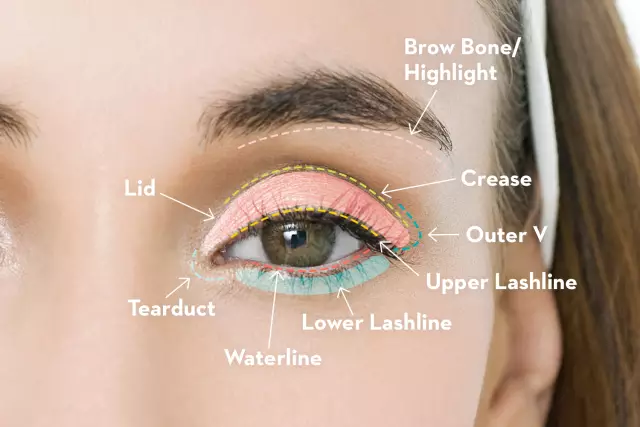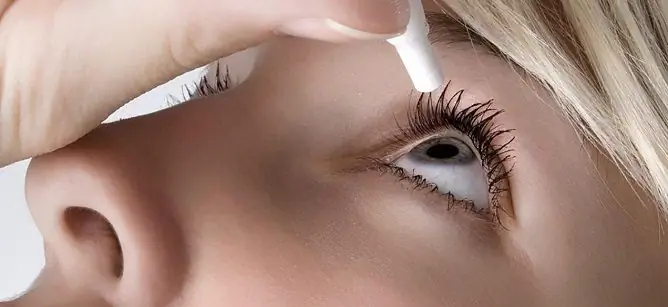- Author Rachel Wainwright [email protected].
- Public 2023-12-15 07:39.
- Last modified 2025-11-02 20:14.
Betoptic
Betoptic: instructions for use and reviews
- 1. Release form and composition
- 2. Pharmacological properties
- 3. Indications for use
- 4. Contraindications
- 5. Method of application and dosage
- 6. Side effects
- 7. Overdose
- 8. Special instructions
- 9. Application during pregnancy and lactation
- 10. Use in childhood
- 11. Drug interactions
- 12. Analogs
- 13. Terms and conditions of storage
- 14. Terms of dispensing from pharmacies
- 15. Reviews
- 16. Price in pharmacies
Latin name: Betoptic
ATX code: S01ED02
Active ingredient: Betaxolol
Producer: Alcon-Couvreur NVSA (Belgium)
Description and photo update: 2019-06-08
Prices in pharmacies: from 185 rubles.
Buy

Betoptic is a synthetic drug used in the treatment of open-angle glaucoma.
Release form and composition
Dosage form - 0.5% eye drops: colorless transparent solution (in Drop Tainer plastic dropper bottles, 5 ml).
1 ml of eye drops contains:
- Active ingredient: betaxolol - 5 mg;
- Excipients: hydrochloric acid and / or sodium hydroxide solution, benzalkonium chloride, purified water.
Pharmacological properties
Pharmacodynamics
The active substance of Betoptic is betaxolol, which is a selective beta 1 -adrenoceptor blocker, which does not possess internal sympathomimetic activity and a local anesthetic (membrane stabilizing) effect.
When applied topically, betaxolol reduces both increased and normal intraocular pressure, reducing the production of intraocular fluid. The antihypertensive effect is usually achieved within 30 minutes after the application of the drug, and the ophthalmotonus decreases maximally after about 2 hours. A single instillation allows you to maintain the effect on ophthalmotonus for 12 hours. Unlike other beta-blockers, betaxolol does not impair blood flow in the optic nerve. Compared with miotics, when using Betoptic, there are no side effects such as the "veil" effect before the eyes, accommodation spasm, hemeralopia, miosis.
Pharmacokinetics
Betaxolol is highly lipophilic, therefore it almost completely penetrates through the cornea into the anterior chamber, where its maximum level is determined 20 minutes after administration. When applied topically, systemic absorption is low, and the content of betaxolol in plasma does not reach the detection threshold (2 ng / ml). The active component of Betoptic is excreted mostly through the kidneys.
Indications for use
Betoptik eye drops are prescribed to reduce intraocular pressure in the treatment of the following diseases:
- Ocular hypertension;
- Open-angle glaucoma.
The drug is used as monotherapy or concurrently with other drugs.
According to the instructions, Betoptic can be used to treat open-angle glaucoma or ocular hypertension in patients with diseases of the respiratory system.
Contraindications
The use of Betoptic is contraindicated in case of hypersensitivity to the components of the drug.
The drug is prescribed with caution in the presence of diseases such as:
- Myasthenia gravis;
- Cardiogenic shock;
- Sinus bradycardia;
- Severe heart failure;
- AV block II and III degree;
- Diabetes.
The question of the possibility of using Betoptic by nursing and pregnant women is decided individually by the doctor after assessing the "benefit-risk" ratio for the health of the woman and the child / fetus.
Instructions for the use of Betoptic: method and dosage
Betoptic eye drops should be instilled into the conjunctival sac, 1-2 drops twice a day.
It is recommended to monitor intraocular pressure within a month from the moment the drug is started, since in many patients, intraocular pressure stabilization occurs in the first weeks of treatment.
If the clinical effect is insufficient, the doctor may prescribe additional therapy.
Side effects
When using eye drops, lacrimation and short-term discomfort in the eyes most often occur. Also, during treatment, the following disorders may develop:
- Organ of vision: itching, redness of the eyes, decreased sensitivity of the cornea, photophobia, punctate keratitis, photophobia, anisocoria, dry eyes;
- Central nervous system: depressive neuroses, insomnia.
Overdose
If a large amount of the drug gets into the eyes, they should be rinsed with warm water.
In case of accidental oral administration of the drug, an overdose may be evidenced by bronchospasm, hypotension, bradycardia, heart failure in acute form. In this case, symptomatic and supportive therapy is prescribed.
special instructions
Since Betoptic can be absorbed into the systemic circulation, during treatment, the same side effects may develop as with systemic use, including respiratory and cardiovascular disorders.
Despite the fact that Betoptic minimally affects blood pressure and heart rate, its use should be stopped immediately when the first symptoms of decompensation from the cardiovascular system occur.
Care must be taken with the simultaneous use of adrenergic psychotropic drugs.
In cases where, after the instillation of the drug in patients, the clarity of vision temporarily decreases, until it is restored, one should refrain from driving.
Application during pregnancy and lactation
A clear relationship between the reception of Betoptic and its effect on fertility has not been identified.
It is not recommended to prescribe the drug during pregnancy, except in cases when it is vital. There is no sufficient clinical experience confirming the safety of betaxolol treatment during this period.
In accordance with the results of epidemiological studies, malformative effects were not found, but when beta-blockers are taken orally, the risk of intrauterine growth retardation is significantly increased. Also, in newborns whose mothers took similar drugs during pregnancy, symptoms of β-blockade were detected: hypoglycemia, hypotension, bradycardia, and respiratory distress syndrome. In such cases, mandatory monitoring of the condition of infants in the first weeks of life is required.
Betaxolol passes into breast milk and can cause severe adverse reactions in breastfed babies. However, when using the drug in recommended doses in breast milk, it is unlikely that such an amount of active substance is present that could provoke the appearance of clinical signs of β-blockade in newborns.
The attending physician may prescribe Betoptic therapy to a nursing mother, provided that the intended benefit outweighs the risk of developing possible side effects.
Pediatric use
Clinical experience with the drug in this category of patients is insufficient.
Drug interactions
With the simultaneous use of other beta-blockers orally, the risk of undesirable local or systemic reactions increases due to a possible additive effect. Such patients must always remain under the supervision of the attending physician.
The combination of betaxolol and oral forms of calcium channel blockers, drugs that deplete catecholamines (for example, reserpine), beta-blockers, guanethidine, antiarrhythmic drugs (including amiodarone), parasympathomimetics and digitalis glycosides can cause a sharp decrease in blood pressure and an increase in bradycardia.
In some cases, the result of the simultaneous administration of adrenaline (epiphrine) may result in mydriasis. When the drug is combined with hypoglycemic agents and muscle relaxants, an increase in the action of the latter is often observed.
Betoptic, when combined with adrenaline, used for anaphylactic reactions, can worsen the effect of the latter on the body, therefore it is prescribed with caution to patients with a history of anaphylaxis or atopy.
Joint use with sympathomimetics causes an increase in their vasoconstrictor action.
The combination of betaxolol and adrenergic psychotropic drugs requires constant medical monitoring due to the likely increase in the action of the latter.
If necessary, Betoptic is prescribed in combination with other ophthalmic drugs. However, the interval between their introduction should be at least 10 minutes.
Analogs
Betoptic's analogs are:
- According to the active substance - Betoptik C, Xonef BK, Betoftan, Xonef, Betaxolol, Optibetol;
- According to the mechanism of action - Oftan Timolol, Niolol, Okumed, DuoTrav, Timolol, Okumol, Anaprilin, Combigan, Azarga, Ganfort, Ksalakom, Duoprost, Okuker, Timadren, TimoGeksal.
Terms and conditions of storage
The drug is dispensed by prescription (list B.).
Shelf life - 3 years at a temperature of 8-30 ° C.
After opening the bottle, the medicine must be used within 1 month.
Terms of dispensing from pharmacies
Dispensed by prescription.
Reviews about Betoptics
Despite the relatively high cost, Betoptic reviews are mostly positive. According to patients, the drug is very effective in glaucoma and can be used to normalize intraocular pressure. Its regular use often even helps to avoid surgical intervention for ophthalmic diseases.
However, Betoptic can only be used as directed by a doctor and under constant medical supervision. Also, it does not always relieve all the symptoms of increased intraocular pressure: some of them, for example, headache, have to be eliminated with other drugs.
Price for Betoptik in pharmacies
The price of Betoptic in pharmacies is approximately 350-400 rubles (for a 5 ml dropper bottle).
Betoptik: prices in online pharmacies
|
Drug name Price Pharmacy |
|
Betoptic C 0.25% eye drops 5 ml 1 pc. RUB 185 Buy |
|
Betoptic 0.5% eye drops 5 ml 1 pc. 337 r Buy |
|
Betoptik C eye drops 0.25% 5ml 345 r Buy |

Anna Kozlova Medical journalist About the author
Education: Rostov State Medical University, specialty "General Medicine".
Information about the drug is generalized, provided for informational purposes only and does not replace the official instructions. Self-medication is hazardous to health!






